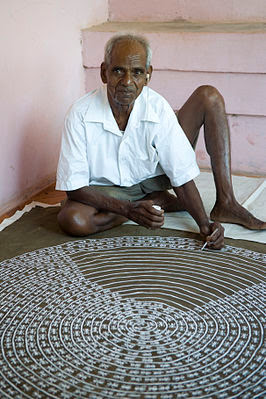Jivya Soma Mashe is an internationally acclaimed Warli painting artist. A tribal artist from India, Mashe was known for wonderful Warli paintings, which owe their origin to prehistoric rock art. Warli painting allocates aesthetics to everyday life instead of traditions. Additionally, it is a method of a celebratory act by the community, rather than an ad hoc aimed to convey a message. Mashe and his family were lifelong proponents of Warli art, reviving its form and content in the contemporary milieu.
Warli is the name of a tribe based in a couple of towns of Western India. Etymologically, waral in Warli means a piece of land. As suggested, ancestors would spare a part of their land, amidst a forest, to irrigate. Subsequently, the Warli tribe became known for its minimalist art form. According to the tribal art convention, the form of the circle derives from the sun and moon. At the same time, the triangle is from trees and mountains. Finally, a square, which is pure and devoid of origin, encloses the main deity, called Palghata in chauk.
Instead of representing religious and mythological subjects, they are known to render social and customary life commemoratively. Hence, a central figure plays a musical instrument called Tarpa. Surrounding him in a circle, the villagers dance, interlocking their hands with alternate partners. Furthermore, Warli painting artists depict scenes of farming, smithing, and fishing, among others.
In the process of the Warli art, artists prepare the wall with brick, geru, and branches. They use chewed bamboo sticks to paint with rice paste bound by a certain gum. However, today the artists have switched to canvas, paper, and brushes.























No comments:
Post a Comment